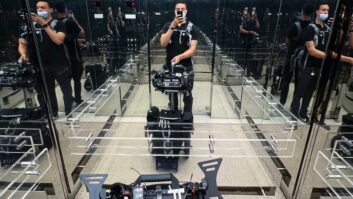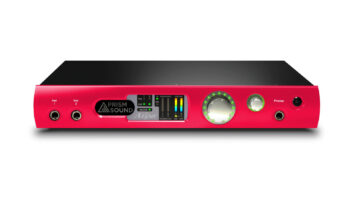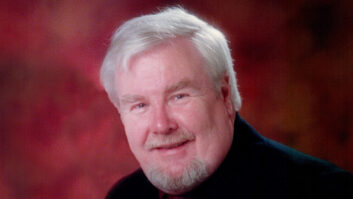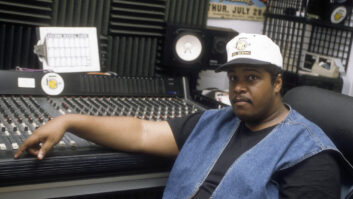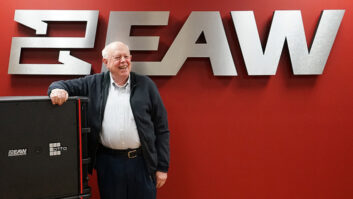Hollywood, CA – As the castaways held their collective breath waiting for the million-dollar prize to be awarded, the grand finale of Survivor: China put CONEQ to the test as well.
The much talked about invention from Latvian technology company Real Sound Lab, CONEQ survived close scrutiny during the setup and rehearsals of Survivor: China, to become a Tribal Leader in its own right. As the host loudly proclaimed “Live from CBS Television City,” the scene shifted seamlessly from taped footage of the last Tribal Council in a remote part of China, to Sound Stage 46 at CBS in Hollywood. The 16 “castaways” of this popular reality TV show were all present, the final three contenders were on the edge of their seats, and the million-dollar winner was about to be announced. The audience was going wild!
Standing for CONvolution EQualization, CONEQ is an advanced audio processing system that flattens and naturalizes the sound quality of loudspeakers to a degree that has previously been unknown. Suitable for applications ranging from large-scale PA systems all the way down to studio monitors, a CONEQ measurement, and the resultant 4096 point amplitude correction, is based on Acoustic Power instead of the standard SPL measurements that have previously dominated the sound industry. On the Survivor set, ten channels of CONEQ correction were used to equalize the sizeable system provided by Production Resources Group (http://www.prg.com/people/bdaly).
While Survivor provides its loyal fans with the opportunity to bond with the contestants and live vicariously through them as they go through the process of reaching the finish line (without having to actually eat bugs and chicken feet), CONEQ ensured that the live audience at the finale could clearly hear and enjoy the final moments leading up to the election of the sole survivor.
As challenging as it is to “survive” on a remote island, it‘s perhaps equally challenging to mic 16 diverse contestants, none of whom are trained actors, and enable them to be heard over the substantial crowd noise generated by the loyal fans of the show. CONEQ did this effortlessly, as well as significantly streamlining the workflow for the CBS crew.
“The CONEQ tuning process is about as painless as it gets,” stated Bill Daly, Survivor‘s sound designer and lead mixing engineer. “The usual time I allocate for system tuning with an FFT was cut in half, while the results were better than I could have imagined. On a major live telecast like Survivor, I normally allocate two nights for system tuning. With CONEQ, I was ready for rehearsals in just one.”
A CONEQ measurement is made by moving the measurement mic around the sound source for a period of about two minutes, during which time several hundred data points are acquired. The data points are then processed by the CONEQ computational engine, revealing the true Acoustic Power of the sound system. Simultaneously, CONEQ synthesizes a 4096 point correction curve which is then uploaded to a two-channel APEQ equalizer.
“My rack of ‘emergency graphics‘ was literally left untouched, as were the EQ filters on my 10 channels of XTA loudspeaker processors,” observes Daly. “The ten channels of CONEQ correction were all that I needed. The sound for the telecast was smooth as silk, and in particular, I‘ve never heard the main arrays sound better.”
“During the show,” he continues, “I‘d occasionally introduce a small amount of channel EQ to the dialog mics. I‘ve never heard a sound reinforcement system respond to these small touch-ups like this one did. CONEQ is the most effective system alignment tool I‘ve ever used.”
The Survivor system included five CONEQ APEQ Acoustic Power Equalizers (ten channels), left and right dV-Dosc main arrays, two arrays of Meyer M1Ds for down-fill, a row of d&b C-6s for delay fill, and 72 Apogee SSMs plus 64 Apogee SAT-3s for front fill and under-seat fill. Two Yamaha M7-CLs were used for house, while a PM1D and a PM-4000 handled monitor duties.
“CONEQ has changed my way of working,” Daly stated emphatically. “In the past, I‘ve always set the PA at a comfortable level for the air mixers, and then I use my cue speakers at the console to mix the show. That was the only way I could catch the nuances I needed to hear, in order to make fractional EQ and level decisions.
“With CONEQ it‘s a new ball game. I‘m mixing entirely from what I hear out of the PA, which is the way it ought to be. I use the cue speakers just to preview channels before bringing them up in the house,” he concludes.
CONEQ is the development of Real Sound Lab, Riga, Latvia (www.realsoundlab.com).


